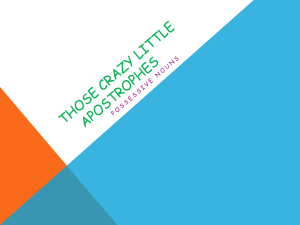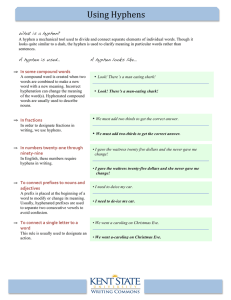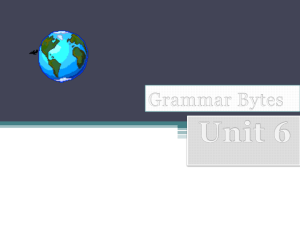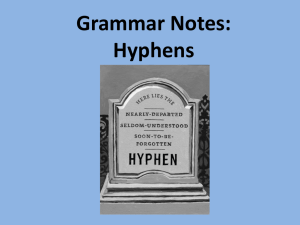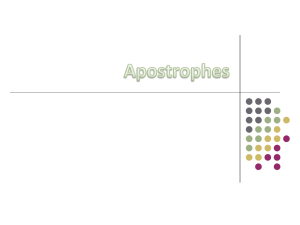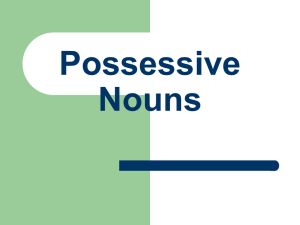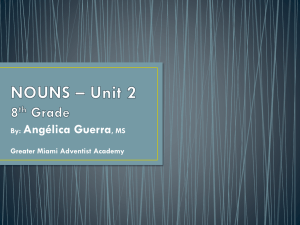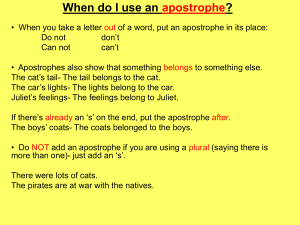hyphens and apostrophes
advertisement
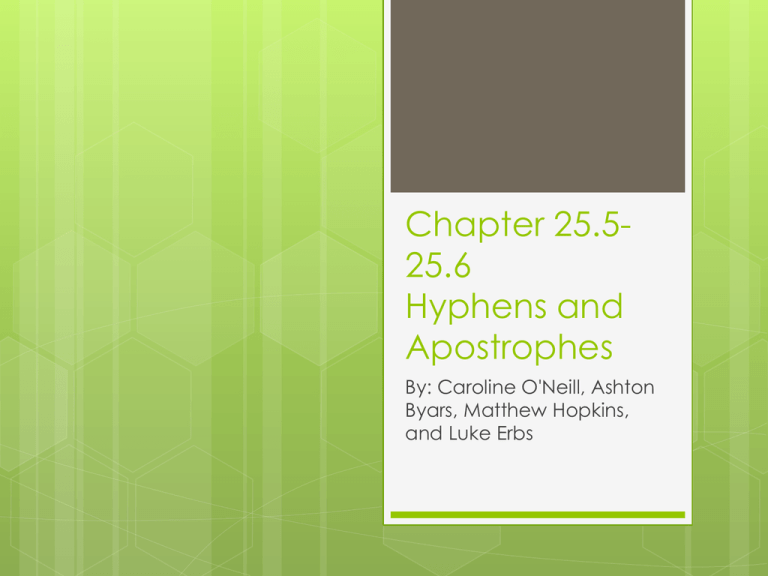
Chapter 25.525.6 Hyphens and Apostrophes By: Caroline O'Neill, Ashton Byars, Matthew Hopkins, and Luke Erbs Hyphens Hyphens are used to combine words and to show a connection between the syllables of words that are broken at the ends of lines. Numbers Hyphens are used to join compound numbers and fractions. When writing two word numbers from twenty-one through ninety-nine, use hyphens. Ex) twenty- three Ex) eighty-five Fractions When you use a fraction as an adjective, use a hyphen, but when you use a fraction as a noun, do not use a hyphen. Ex) adjective: Matthew’s hair is three-fourths black and one-fourth purple. Ex) noun: One fifth of the class is absent. Prefixes and Suffixes When using a prefix that is followed by a proper noun or adjective, use a hyphen. ex) Mid-October; Pre-World War II In words with the prefixes all-, ex-, and self- and the suffix –elect, remember to use a hyphen. Ex) All-in; Ex-girlfriend Compound Words and Compound Modifiers To connect two or more nouns (unless a dictionary gives a different definition) make sure to use a hyphen. • Ex)nine-year-olds; father-in-law use hyphens when a compound modifier comes before a noun, but do not use a hyphen with a compound modifier that includes a word ending in –ly or in a compound proper adjective Ex) I will have a well-cooked burger. Hyphens at the end of lines Try to avoid dividing words at the end of a line as much as possible, but if a word must be divided, divide it between syllables. Ex) You are a nice person that likes watching T.V. Remember to never place a hyphen at the beginning of a line. Correctly Dividing Words Do not divide one-syllable words. Ex) Incorrect: Th-ink Do not divide a word to make a single letter stand alone. Ex) incorrect: A-go Correct: Think correct: Ago Avoid dividing both proper nouns or proper adjectives. Ex) incorrect- Engl-ish correct- English • Divide a hyphenated word only immediately following existing hyphen. Ex) incorrect: Luke gave an up-to-the-minute countdown. Ex)Correct: Luke gave an up-to-theminute countdown. Apostrophes with Possessive Nouns Apostrophes are used with nouns to show ownership or possession. Add an apostrophe and -s to show the possessive case of most singular nouns and plural nouns that do not end in -s or -es. Ex) Stephen’s sister won the prize. Even when a singular noun already ends in -s, you can usually add an apostrophe and -s to show possession. Ex) Matthew Hopkins’s paper is short and sweet. Apostrophes with possessive nouns cont. In classical or ancient names that end in -se, it is common to omit the final -s to make pronunciation easier. Ex) Jesus’ life was worth more than we can imagine. Ex) Ulysses’ boat was very big. Add an apostrophe to show the possessive case of plural nouns ending in -s or -es. Do not add an -s. Ex) The glasses’ lens were very dirty. Possessive noun cont. Add an apostrophe and -s (or just an apostrophe if the word is plural ending in -s) to the last word of a compound noun to form the possessive. Ex) My sister-in-law’s brother came over. Apostrophes with pronouns Use an apostrophe and -s with indefinite pronouns to show possession. Ex) Somebody’s jacket • Do not use an apostrophe with possessive personal pronouns. Ex) The boy left his jacket at the game. Apostrophes with contractions Use an apostrophe in a contraction to show where one or more letters have been omitted. • Ex) is not= isn’t Ex) they are= they’re Avoid contractions in formal speech and writing Apostrophes to create plurals Use an apostrophe and –s to create the plural form of a letter, numeral, or a word uses as a name for itself. Ex) There are three A’s on his report card. The End!

